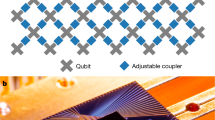Abstract
Determining classically whether a coin is fair (head on one side, tail on the other) or fake (heads or tails on both sides) requires an examination of each side. However, the analogous quantum procedure (the Deutsch–Jozsa algorithm1,2) requires just one examination step. The Deutsch–Jozsa algorithm has been realized experimentally using bulk nuclear magnetic resonance techniques3,4, employing nuclear spins as quantum bits (qubits). In contrast, the ion trap processor utilises3 motional and electronic quantum states of individual atoms as qubits, and in principle is easier to scale to many qubits. Experimental advances in the latter area include the realization of a two-qubit quantum gate6, the entanglement of four ions7, quantum state engineering8 and entanglement-enhanced phase estimation9. Here we exploit techniques10,11 developed for nuclear magnetic resonance to implement the Deutsch–Jozsa algorithm on an ion-trap quantum processor, using as qubits the electronic and motional states of a single calcium ion. Our ion-based implementation of a full quantum algorithm serves to demonstrate experimental procedures with the quality and precision required for complex computations, confirming the potential of trapped ions for quantum computation.
This is a preview of subscription content, access via your institution
Access options
Subscribe to this journal
Receive 51 print issues and online access
$199.00 per year
only $3.90 per issue
Buy this article
- Purchase on Springer Link
- Instant access to full article PDF
Prices may be subject to local taxes which are calculated during checkout



Similar content being viewed by others
References
Deutsch, D. Quantum theory, the Church-Turing principle and the universal quantum computer. Proc. R. Soc. Lond. A 400, 97–117 (1985)
Deutsch, D. & Jozsa, R. Rapid solution of problems by quantum computation. Proc. R. Soc. Lond. A 439, 553–558 (1992)
Chuang, I. I., Vandersypen, I. M. K., Zhou, X., Leung, D. W. & Lloyd, S. Experimental realization of a quantum algorithm. Nature 393, 143–146 (1998)
Jones, T. F. & Mosca, M. Implementation of a quantum algorithm to solve Deutsch's problem on a nuclear magnetic resonance quantum computer. J. Chem. Phys. 109, 1648–1653 (1998)
Cirac, J. I. & Zoller, P. Quantum computations with cold trapped ions. Phys. Rev. Lett. 74, 4091–4094 (1995)
Monroe, C., Meekhof, D. M., King, B. E., Itano, W. M. & Wineland, D. J. Demonstration of a fundamental quantum logic gate. Phys. Rev. Lett. 75, 4714–4717 (1995)
Sackett, C. A. et al. Experimental entanglement of four particles. Nature 404, 256–259 (2000)
Roos, Ch. et al. Quantum state engineering on an optical transition and decoherence in a Paul trap. Phys. Rev. Lett. 83, 4713–4716 (1999)
Meyer, V. et al. Experimental demonstration of entanglement-enhanced rotation angle estimation using trapped ions. Phys. Rev. Lett. 86, 5870–5873 (2001)
Childs, A. M. & Chuang, I. M. Universal quantum computation with two-level trapped ions. Phys. Rev. A 63, 012306 (2001)
Levitt, M. H. Composite pulses (NMR spectroscopy). Prog. Nucl. Magn. Reson. Spectrosc. 18, 61–122 (1986)
Šašura, M. & Bužek, V. Cold trapped ions as quantum information processors. J. Mod. Opt. 49, 1593–1647 (2002)
Eschner, J., Raab, Ch., Schmidt-Kaler, F. & Blatt, R. Light interference from single atoms and their mirror images. Nature 413, 495–498 (2001)
Guthöhrlein, G. R., Keller, M., Hayasaka, K., Lange, W. & Walther, H. A single ion as a nanoscopic probe of an optical field. Nature 414, 49–51 (2001)
Mundt, A. B. et al. Coupling a single atomic quantum bit to a high finesse optical cavity. Phys. Rev. Lett. 89, 103001 (2002)
Meekhof, D. M., Monroe, C., King, B. E., Itano, W. M. & Wineland, D. J. Generation of nonclassical motional states of a trapped atom. Phys. Rev. Lett. 76, 1796–1799 (1996)
Monroe, C., Meekhof, D. M., King, B. E. & Wineland, D. J. A “Schrödinger Cat” superposition state of an atom. Science 272, 1131–1136 (1996)
Dehmelt, H. Proposed 1014Δν > ν laser fluorescence spectroscopy on TI+ mono-ion oscillator. Bull. Am. Phys. Soc. 20, 60 (1975)
Nägerl, H. C. et al. Investigating a qubit candidate: Spectroscopy on the S1/2 to D5/2 transition of a trapped calcium ion in a linear Paul trap. Phys. Rev. A 61, 023405 (2000)
Häffner, H. et al. Precision measurement and compensation of optical Stark shifts for an ion-trap quantum processor. Preprint available at 〈http://arXiv.org/abs/physics/0212040〉 (2002).
Nielsen, M. A. & Chuang, I. J. Quantum Computation and Quantum Information (Cambridge Univ. Press, Cambridge, 2000)
Schmidt-Kaler, F. et al. Coherence of qubits based on single Ca ions. Preprint available at 〈http://arXiv.org/abs/quant-ph/0211059〉 (2002).
Acknowledgements
We gratefully acknowledge support by the European Commission (QSTRUCT, QI, QUEST and QUBITS networks), by the Austrian Science Fund (FWF), and by the Institut für Quanteninformation GmbH.
Author information
Authors and Affiliations
Corresponding author
Ethics declarations
Competing interests
The authors declare that they have no competing financial interests.
Rights and permissions
About this article
Cite this article
Gulde, S., Riebe, M., Lancaster, G. et al. Implementation of the Deutsch–Jozsa algorithm on an ion-trap quantum computer. Nature 421, 48–50 (2003). https://doi.org/10.1038/nature01336
Received:
Accepted:
Issue Date:
DOI: https://doi.org/10.1038/nature01336
This article is cited by
-
Quantum face recognition protocol with ghost imaging
Scientific Reports (2023)
-
Quantum Audio Steganalysis Based on Quantum Fourier Transform and Deutsch–Jozsa Algorithm
Circuits, Systems, and Signal Processing (2023)
-
Geometric property of off resonance error robust composite pulse
Scientific Reports (2022)
-
NISQ computing: where are we and where do we go?
AAPPS Bulletin (2022)
-
An injection-locked 1762 nm laser for trapped barium ion qubits
Applied Physics B (2022)
Comments
By submitting a comment you agree to abide by our Terms and Community Guidelines. If you find something abusive or that does not comply with our terms or guidelines please flag it as inappropriate.



